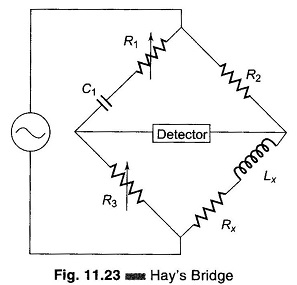Hays Bridge Circuit:
Hays Bridge Circuit, shown in Fig. 11.23, differs from Maxwell’s bridge by having a resistance R1 in series with a standard capacitor C1 instead of a parallel. For large phase angles, R1 needs to be low; therefore, this bridge is more convenient for measuring high-Q coils. For Q = 10, the error is ± 1%, and for Q = 30, the error is ± 0.1%. Hence Hay’s bridge is preferred for coils with a high Q, and Maxwell’s bridge for coils with a low Q.
At balance
Substituting these values in the balance equation we get
Equating the real and imaginary terms we have
and
Solving for Lx and Rx we have, Rx = ω2LxC1R1.
Substituting for Rx in Eq. (11.16)
Multiplying both sides by C1 we get
Therefore,
Substituting for Lx in Eq. (11.17)
The term ω appears in the expression for both Lx and Rx. This indicates that the bridge is frequency sensitive.
The Hays Bridge Circuit is also used in the measurement of incremental inductance. The inductance balance equation depends on the losses of the inductor (or Q) and also on the operating frequency.
An inconvenient feature of this bridge is that the equation giving the balance condition for inductance, contains the multiplier 1/(1 + 1/Q2). The inductance balance thus depends on its Q and frequency.
Therefore,
For a value of Q greater than 10, the term 1/Q2 will be smaller than 1/100 and can be therefore neglected.
Therefore Lx = R2R3C1, which is the same as Maxwell’s equation. But for inductors with a Q less than 10, the 1/Q2 term cannot be neglected. Hence this bridge is not suited for measurements of coils having Q less than 10. A commercial bridge measure from 1 μ H – 100 H with ± 2% error.








